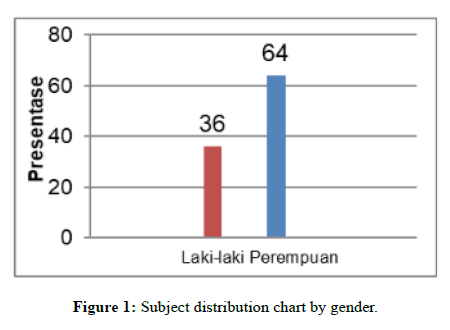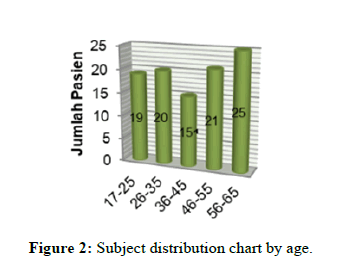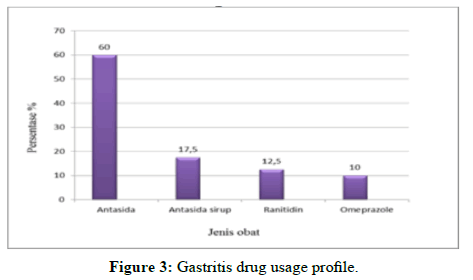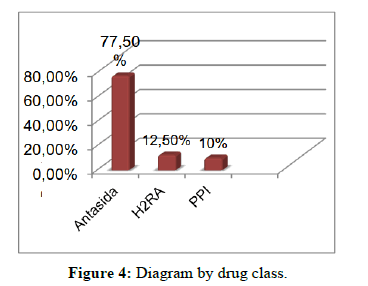HTML
Research Article - (2021) Volume 11, Issue 10
Evaluation of Gastritis Drug Use in Output Poly Patients Upt Puskesmas Inspiring Way Kandis Bandar Lampung Period January-March 2019
Elfa Rahmi*, Akhmad Rokiban and Adniana Yeliza*Correspondence: Elfa Rahmi, Department of Clinical Pharmacy, Tulang Bawang University, Lampung, Indonesia, Email:
Received: 25-Nov-2021 Published: 16-Dec-2021
Abstract
Objective: Gastritis will be very annoying every day, both for teens and adults. If this disease is left, it will damage the function of the stomach and increase the risk of stomach cancer which will cause death. The aim of this research was to know the accuracy of using gastritis medicine to the outpatients at UPT Puskesmas Rawat Inap Way Kandis.
Methods: This research was non experimental research with descriptive design that was taken by retrospective. The sample taken was the medical record data of patients with a diagnostic of gastritis without complications with other diseases in January-March 2019. Total sampling is this study using purposive sampling.
Conclusion: Rationality evaluation results the parameters used in the use of the medicine are right patient, right indication, right medicine, and right dose. Right patient 100%, right indication 100%, right medicine 100%, right dose 87, 50%.
Keywords
Gastritis, Type of medicine, Drug use.
Introduction
Gastritis or a term that is often known by the public as an ulcer or gastric disease is a collection of symptoms that are felt as pain, especially in the pit of the heart, people who are attacked by this disease usually often have nausea, vomiting, feeling full, and feeling uncomfortable [1]. According to data from the World Health Organization (WHO), Indonesia ranks fourth with the highest number of gastritis sufferers after America, Bangladesh and England, which are 430 million gastritis sufferers. The incidence of gastritis in Southeast Asia is about 583,635 of the total population each year [2]. In Indonesia in 2005 gastritis was ranked third with the number of sufferers as many as 405 patients, this was caused by irregular eating patterns, in 2006 gastritis was a digestive tract disease which was ranked second suffered by patients with a very high prevalence rate of 151,833 patients with percentage 14.8%. This is caused by a poor diet due to low purchasing power or due to stress and emotional behavior [3]. Based on data from the Lampung provincial health office, gastritis ranks ninth out of the ten most common diseases in Lampung in 2015 [4]. In 2016 gastritis ranks fourth with a total of 219,232 [5]. Drug use evaluation (EPO) is to ensure appropriate drug therapy. An EPO program that ensures the quality of drug use must be carried out continuously, authorized, and structured must measure (evaluate) drug use against predetermined use criteria and most importantly initiate changes in the use of drugs that do not meet these criteria [6]. Upt Inpatient Health Centre Way Kandis noted that in 2016 gastritis was ranked second after nasopharyngitis as many as 3,131 cases of gastritis, in 2017 gastritis was in second place suffered by patients with a total of 3,751 cases. In 2018 gastritis was ranked sixth with a total of 1,012 cases [7]. Based on the description above, the author wants to raise a research problem, namely how to evaluate the use of gastritis drugs in outpatient polyclinics at the Upt Inpatient Health Centre Way Kandis. The use of the drug is carried out by looking at aspects of the accuracy of drug use, namely the right patient, the right indication, the right drug, and the right dose so that treatment therapy is achieved so that success in a treatment is achieved and minimized so that unwanted disease recurrence does not occur.
Materials and Methods
Research methods
Research plan: This study uses a non-experimental with a descriptive research design that uses a retrospective approach.
Research time: This research was conducted in September 2019.
Research place: This research was conducted at Upt Health Centre Inpatient Way Kandis Bandar Lampung.
Population and sample
Population: The population in this study were patients suffering from gastritis in the outpatient polyclinic of the Way Kandis Inpatient Health Centre for the period January-March 2019.
Sample: The sample in this study were patients suffering from gastritis at the outpatient clinic of the Way Kandis Inpatient Health Center for the period January-March 2019 who met the inclusion criteria.
Sampling technique
The sampling technique was carried out by purposive sampling, namely the research sampling technique based on the characteristics that had been determined or desired by the researcher. Calculation of the sample using the sloving formula;
n=N/1+N(d)2
n=number of samples
N=total population
d=confidence level (0.05)
Based on the formula above, the sample size required in this study is 100 samples.
Result and Discussion
Characteristics of subjects based on gender and age
Based on the results of the study, 100 samples of medical record data were obtained from patients diagnosed with gastritis. Of the 100 patients by gender, 36 men (36%), and 46 women (46%) (Figure 1).
This shows that more female patients suffer from gastritis than men. This can be caused because women are more easily stressed, according to Maulidiyah. This result is also reinforced by another study conducted by Rahma, et al. which reported that women are at greater risk of developing gastritis and suffer from gastritis more than men. This is because women pay more attention to their body image so that many of them delay eating, reduce the portion of eating according to their needs, even long fasts in order to have ideal body portions, as well as teenagers and the age of early adulthood and late adulthood are not much different (Figure 2) [8,9].
This shows that of the 7 groups of patients, which occurred more in patients aged 56-65 years, as many as 25 patients (25%), age 46-55 years as many as 21 patients (21%), age 26-35 years as many as 20 patients (20%), age 17-25 years as many as 19 patients (19%), age 36-45 years as many as 15 patients (15%). This is in accordance with the research and explanation of Lombeng's thesis , that older people are more prone to gastritis than young people. This is because with increasing age the gastric mucosa tends to become thinner so that it is easier to be infected with Helicobacter pylori or autoimmune, while at a young age the incidence of gastritis is more related to an unhealthy lifestyle. The incidence of chronic gastritis increases with increasing age (Figure 3) [10].
Distribution of profile based on drug class of gastritis patients
Based on the picture above, it shows that the most widely used are the antacid group, because the antacid group can reduce the acidity of gastric juices, including antacids that directly neutralize gastric juices, by acting as a buffer against gastric hydrochloric acid which normally has a pH of 1-2. Based on clinical practice guidelines for primary care physicians in 2014 issued by the Ministry of Health of the Republic of Indonesia (Depkes RI) and the Indonesian physician association, the therapies provided include H2RA (Ranitidine, famotidine, cimetidine), PPI (omeprazole, lansoprazole) and antacids (Figure 4) [11-13].
Characteristics of drug use patterns based on the right patient
The pattern of drug use is based on the exact patient from 100 outpatient gastritis patients at the Way Kandis Inpatient Health Centre Bandar Lampung for the January-March 2019 period, which consists of 100% correct patients out of 100 patients. Based on the table above shows the use of drugs with the right patient parameters. In this case, the patient is said to be right because based on treatment therapy aimed at the patient, the signs and symptoms are shown according to the clinical manifestations. The clinical manifestation of gastritis is characterized by a burning sensation in the stomach which often accompanies gastritis. This can be caused by an inflammatory process that occurs due to irritation of the gastric mucosa. Symptoms of gastritis are not only it hurts but discomfort in the stomach accompanied by nausea or bloating and often belching or feeling full quickly is also a symptom of gastritis, it hurts but discomfort in the stomach accompanied by nausea or bloating and often belching or feeling full quickly is also a symptom of gastritis (Table 1) [14].
| Parameter | Amount and percentage | Total | |
|---|---|---|---|
| Appropriate | Not exactly | ||
| Right patient | 100 (100%) | 0 (0%) | 100 (100%) |
Characteristics of drug use patterns based on exact indications
Based on table 2 shows the use of gastritis drugs based on precise indications, it shows that from all prescriptions, as many as 100 samples with a percentage of 100% have correct indications. The indication is said to be appropriate because it is based on the prescribed medication according to the diagnosis in the patient's medical record (Table 2).
| Parameter | Amount and percentage | Total | |
|---|---|---|---|
| Appropriate | Not exactly | ||
| Exact indication | 100 (100%) | 0 (0%) | 100 (100%) |
Characteristics of usage patterns based on appropriate drugs
The use of drugs based on the right drug shows that from the total sample, which is 100 samples with the number of drugs used, namely the antacid group, H2 Receptor Antagonist (H2RA), Proton Pump Inhibitor (PPI) the drug is correct with a percentage of 100%. This is in accordance with clinical practical guidelines for primary care physicians in 2014 issued by the Indonesian Ministry of Health and the Indonesian Doctors Association, the therapies provided include H2RA (ranitidine, famotidine, cimetidine), PPI (omeprazole, lansoprazole),and antacids (Table 3).
| S.No. | Type of medicine | Amount | Total | |
|---|---|---|---|---|
| Appropriate | Not exactly | |||
| 1 | Antacid | 67 | 1 | 68 |
| 2 | Antacid syrup | 22 | 0 | 22 |
| 3 | Ranitidine | 43 | 0 | 43 |
| 4 | Omeprazole | 8 | 19 | 27 |
| Total | 140 | 20 | 160 | |
| Percentage | 87.50% | 12.50% | 100% | |
Characteristics of usage patterns based on appropriate dosage
Based on the right dose, it shows that the drug used is of the right type and class of drugs with a percentage of 87.5% as much as 140 of the total and incorrect with a percentage of 12.5% of the total 20.
Based on the table above, it shows that the right drug is in accordance with the standard of treatment based on the literature on ISO pharmacotherapy, important drugs, British National Formulary (BNF). While the drug is not in the right dose because antacid drugs with a dose of 200 mg 2 times a day are not in accordance with the literature. According to ISO Pharmacotherapy, the antacid dose is 200 mg 3 or 4 times a day. In the case of using Omeprazole, 19 prescriptions out of 27 showed incorrect dosages. According to important drugs, the dose for gastritis is 1 dd 20-40 mg. The use of omeprazole 20 mg 2 times a day was used as a treatment regimen for Helicobacter pylori with a combination of antibiotics [15]. In this case, a bacterial test was not performed so that the patient's cause was unknown. The use of the drug omeprazole in this case the doctor prescribes a dose of 20 mg with a frequency of 2 times a day according to the patient's condition.
Conclusions
Based on the results of the research that has been done, it can be concluded that;
1. The number of samples obtained was 100 patients. The sampling technique used is purposive sampling.
2. Characteristics of Subjects Based on Gender and Age of gastritis patients in outpatient polyclinic at the Way Kandis Inpatient Health Center UPT obtained 36 male patients with a percentage of 36%, female patients 46 patients with a percentage of 46%. and based on age, 19 patients were 17-25 years old (19%), 26-35 years old were 20 patients (20%), 36-45 years old were 15 (15%), 46-55 years old were 21 patients (21% ), aged 56-65 years as many as 25 patients (25%).
3. Use of types and classes of gastritis drugs
a. Types of gastritis drugs include antacids (60%), antacid syrup (17.5%), ranitidine (12.5%), and omeprazole (10%). Combination of antacid+ranitidine (51.67%), antacid syrup + ranitidine (10%), omeprazole+antacid (21.67). omeprazole+ranitidine (1.66%), antacid syrup+omeprazole (15%).
b. Gastritis drug groups include antacids (77.5%), H2RA (12.5%), PPI (10%).
c. The rationale of therapy for gastritis patients in outpatient polyclinics at UPT Inpatient Health Center Way Kandis Bandar Lampung obtained that the use of drugs based on the patient's exact parameters was 100%, 100% correct indication, 100% correct drug, and 87.50% correct dose.
References
- Carrière F. Gastroenterology. 2000; 119(4): 949-960.
- Kuna L. J. Clin. Med. 2019; 8(2): 179.
- Riberiro K. Pharmacotherapy. 2021.
- Ministry of Health. Health. 2008.
- Alagarsamy V. World. Cat. 2012.
- Lampung Provincial Health. Health. 2015.
- Lampung Provincial Government Health. GHDc. 2016.
- Gustin RK. Research Gate. 2011.
- Rahayu P, Ayu WD. Cleveland Clinic. 2016.
- Nurjannah M. Int. J. Cancer. 2011; 128(7): 1652-1658.
- Tjay TH. Essential. Med. 2007.
- Almahdy A. J. Higea. Pharma. 2016.
- Primary Health Care. Health. System. 2014.
- Kasron S. Physiology. 2018: 194.
- BNF. Pharmacetical. 2017.
Manuscript Submission
Submit your manuscript at Online Submission System
Google scholar citation report
Citations : 1101
International Journal of Pharmacy received 1101 citations as per google scholar report
International Journal of Pharmacy peer review process verified at publons
Indexed In
- CAS Source Index (CASSI)
- HINARI
- Index Copernicus
- Google Scholar
- The Global Impact Factor (GIF)
- Polish Scholarly Bibliography (PBN)
- Cosmos IF
- Open Academic Journals Index (OAJI)
- Directory of Research Journal Indexing (DRJI)
- EBSCO A-Z
- OCLC- WorldCat
- MIAR
- International committee of medical journals editors (ICMJE)
- Scientific Indexing Services (SIS)
- Scientific Journal Impact Factor (SJIF)
- Euro Pub
- Eurasian Scientific Journal Index
- Root indexing
- International Institute of Organized Research
- InfoBase Index
- International Innovative Journal Impact Factor
- J-Gate





